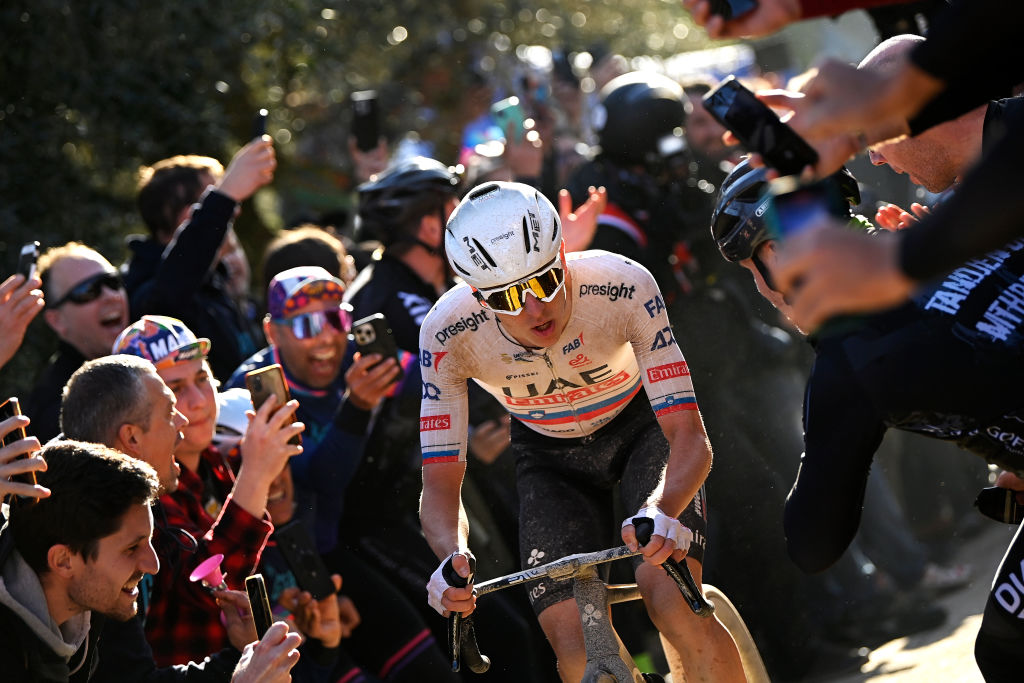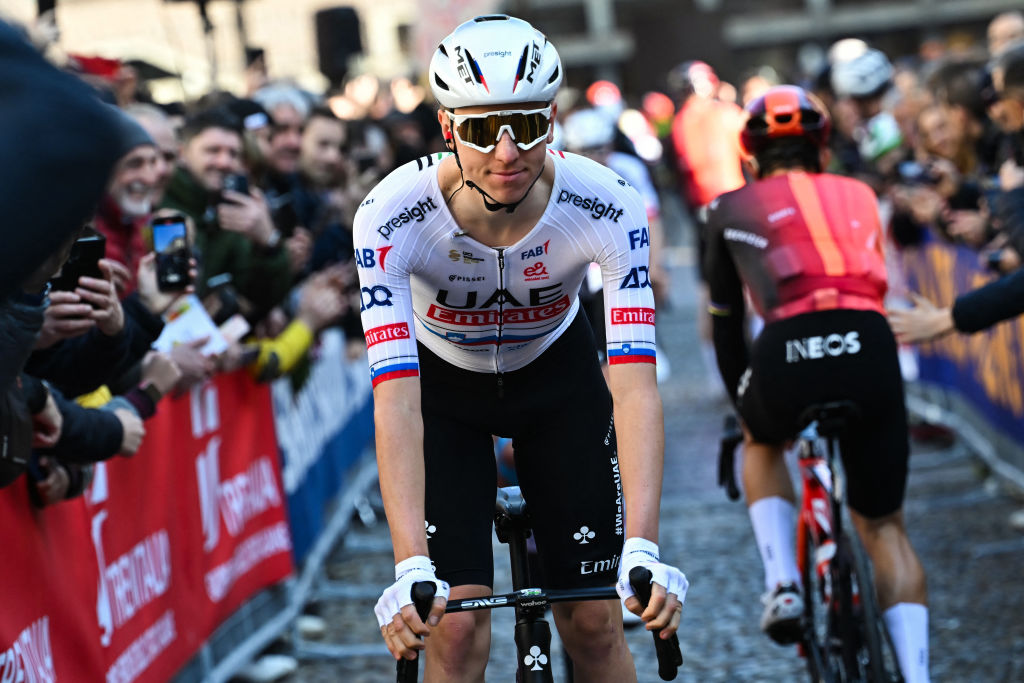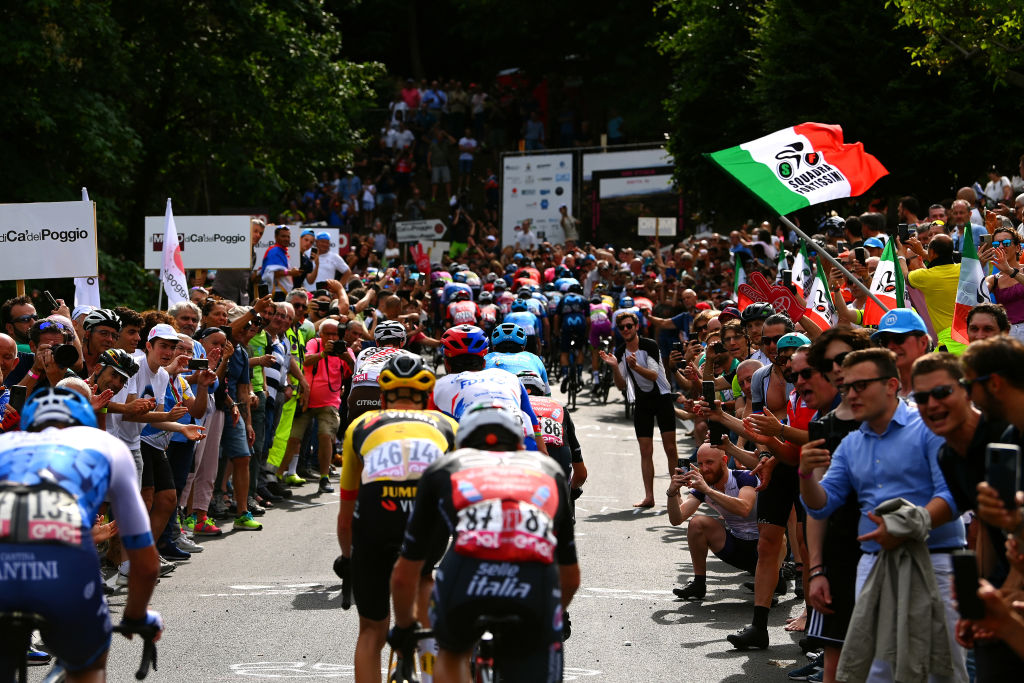
Be careful what you wish for. Mauro Vegni and RCS Sport have been courting Tadej Pogačar to ride the Giro d’Italia for years, but now that he’s finally agreed to turn up, there’s a risk that his very presence and likely dominance, makes the race a foregone conclusion.
That isn’t to denigrate the opposition Pogačar will face in Italy next month in the slightest, it’s simply a sober reflection on the current state of play in the men's peloton. A very restricted cadre of riders and teams are operating on a different plane to everybody else, as results this Spring have again borne out and Pogačar is leading that dominance.
There are only three active riders who genuinely believe they can compete with Pogačar in a head-to-head contest at a Grand Tour, and none of them are racing the Giro. Indeed, all three are currently nursing injuries sustained in the same crash at Itzulia Basque Country, leaving doubts about their ability to challenge him at the Tour de France. In the absence of Jonas Vingegaard, Remco Evenepoel and Primož Roglič, there is but one, stratospheric favourite for this Giro.
Such a situation isn’t exactly new. Giro history has been liberally punctuated by editions where an overwhelming favourite came, saw, and conquered. In 1930, the organisation even paid Alfredo Binda to stay away in the interests of maintaining competitive interest in the event.
In recent times, however, such unassailable frontrunners had become more of a rarity. In the 21st century, perhaps only Alberto Contador in 2011 started a Giro with anything like Pogačar’s level of favouritism. And even that race came with inbuilt suspense of a kind, as Contador was still waiting CAS judgement on his positive doping case at the 2010 Tour de France, and his Giro victory was later scrubbed from the record books.
At this juncture, however, there doesn’t seem to be any obvious impediment to prevent Pogačar from adding the 2024 Giro to a palmarès that already features 70 pro wins. He was immediately the favourite once he formally threw his hat into the ring in December and that status has only grown with each turn of the pedals since his season got underway. In ten race days so far this year, the UAE Team Emirates rider has picked up seven victories and made it all look so disquietingly easy.
There is a lightness and a looseness to just about everything Pogačar does. Even when he spent a few weeks in April sequestered at altitude on Sierra Nevada, he gave the impression that making playful cameos in the Instagram stories of his rivals was of almost as much of a preoccupation as banking training miles.
It felt like cycling’s equivalent of Diego Maradona’s famous warm-up for the 1989 UEFA Cup semi-final in Munich, when the Argentinian, his laces undone, eschewed proper stretching in favour of languidly juggling a football in time with Europop anthem ‘Live is Life’ as it blared from the Olympiastadion public address system.
Like Maradona back then, the Pogačar of 2024 exudes the preternatural calm who knows he's playing a different game to everybody else. These days, he can seemingly do just about whatever he wants and in whatever way he wants to do it, particularly when Vingegaard et al aren’t on hand.
As if to prove the point, he went from Sierra Nevada to Liège-Bastogne-Liège, where he casually rattled off the sixth Monument win of his career with a 34km solo attack that he made look almost routine. As Philippa York pointed out on Cyclingnews, it didn’t even seem like the Slovenian needed to push himself especially close to his limit to do so.
It was an ominous sign for what might follow between Turin and Rome in May. This year, the race for the maglia rosa risks being more of an exhibition than a contest.

Rivals
While Pogačar often looks like he is in a race of his own, he won’t be riding in a vacuum at the Giro, an event that tends to throw up more curveballs than any other on the calendar.
The absence of the rest of the ‘Big Four’ doesn’t mean Pogačar is entirely without challengers either. Those challengers will, however, have to cut their cloth very differently to how Jonas Vingegaard has done at the past two Tours de France – Pogačar is unlikely to be locked in a tense duel for the ages at this Giro.
Geraint Thomas (Ineos Grenadiers) surpassed expectations by challenging Primož Roglič all the way to the final Monte Lussari time trial a year ago, and he returns to the Giro this year with unfinished business. He is also smart enough to realise that he can’t match Pogačar’s most devastating combinations, particularly in the opening two weeks.
Instead, he must absorb the early punishment as best he can in the hope the Slovenian punches himself out as he did on the 2022 Tour or in case he is beset by the kind of ill fortune – crashes, illnesses – that can befall any favourite in any bike race. Thomas also lines up with a reliable team around him, including Thymen Arensman.
Riders like Romain Bardet (DSM-Firmenich-PostNL), Ben O’Connor (Decathlon-AG2R), Daniel Martinez (Bora-Hansgrohe) and Damiano Caruso (Bahrain Victorious) will surely follow a similar template to Thomas. It’s more likely, however, that the riders ostensibly chasing Pogačar instead wind up racing one another for second place. Challenging the Slovenian’s likely supremacy directly might prove a risk too far.
The competition for the podium places should be fierce especially amongst the next generation of Grand Tour riders. The likes of Eddie Dunbar (Jayco-AlUla), Antonio Tiberi (Bahrain Victorious) and Cian Uijtdebroeks (Visma-Lease a Bike) will set out with a top ten finish in mind, and they might well find themselves revising those ambitions upwards as the race draws on. Of course, none of them will expect to lay a glove on Pogačar.
In truth, Pogačar’s biggest rival is likely to be the Giro itself rather than another rider. After all, plenty of Tour champions who ventured south of the Alps over the years have discovered that the Corsa Rosa is not easily tamed. Jacques Anquetil’s first Giro ended in defeat to Charly Gaul in 1959, Bernard Hinault left it late against a resilient Wladimiro Panizza in 1980, and even Miguel Indurain endured difficult moments in 1993 and suffered defeat a year later.
There is, however, little to suggest that Pogačar will be unduly shaken even by the unique challenges of the Giro. He has already regularly raced and won in Italy, and he is thoroughly at home in the most miserable conditions, as his back catalogue demonstrates. Rain and snow in the high mountains shouldn’t knock him off his stride. A rider who with Strade Bianche and the Tour of Flanders on his palmarès is unlikely to get caught out by an ambush on sinuous roads either.
Even this year’s slightly gentler route – with some 20% less climbing than a year ago, by Vegni’s estimate – should play in Pogačar’s favour, and not only because it notionally lightens the load as he attempts the Giro-Tour double. The most recent, backloaded editions of the Giro have been attritional tests of endurance, but his year’s event instead promises to be a race of blistering intensity, a prospect that suits the explosive Pogačar better than anyone.
The tricky opening stage around Turin and the summit finish at Oropa the following day could see Pogačar put his stamp on the Giro from the very outset. From there, everything on the route seems to tailored to a man for all terrains and all seasons.
He will enjoy the sterrato gravel roads on the Tuscan stage to Rapolano Terme and he won't be fazed by the two time trials. He has already won atop Prati di Tivo and Livigno is a familiar training site. Sappada is tucked near the Slovenian border and Monte Grappa is well suited to his gifts.
Everything points to a Pogačar victory at the 2024 Giro d'Italia. The question is not really whether he will the Giro, but how and when.

Twists
And yet while a Pogačar procession is highly likely, it’s not quite inevitable. It never is. The Giro invariably throws up some manner of twist. Three years ago, for instance, Egan Bernal looked to have the title sewn up by the midway point only for his supremacy to fray unexpectedly in the final days. It took the interventions of Jonathan Castroviejo and Dani Martinez to make sure it didn’t unravel completely.
In 2015, Contador was again the dominant force, but even though he led almost from gun to tape, he still had to withstand crashes, punctures, hunger knocks and unstinting Astana aggression before he could finally claim the Trofeo Senza Fine. He was, hardly surprisingly, a shadow of himself at the Tour. The Giro, even in its most predictable years, rarely runs to a tight script.
This year, some 3,400km and more than 44,000m of climbing lie between the start line at Venaria Reale and the finish on the Via dei Fori Imperiali. All sorts of variables will cascade into the path of Pogačar and the gruppo. Ad-hoc alliances will form. Polemics will break out. Some imposing stage profiles will yield tame racing, only for some seemingly nondescript day to produce the most breathless drama imaginable. That is the beauty of the Giro d'Italia.
We can all guess the outcome in Rome at the end of it all, but the story of the Giro is never fully written in advance. Not even for Pogačar.







